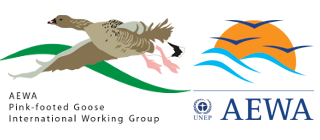Current Size: 76%
Range States
Introduction
The Svalbard population of the Pink-footed Goose migrates through the following 4 countries within the AEWA area: Belgium, Denmark, Norway and The Netherlands.
These so-called "Principle Range States" are listed in the AEWA International Species Management Plan for the Pink-footed Goose and have the major responsibility for the implementation of the plan. Subsequently, these range states are all members of the AEWA Svalbard Pink-footed Goose International Working Group, charged with facilitating the international implementation of conservation and management actions. Countries are seen as belonging to the Principle Range States if they host one or more Important Bird Areas (IBAs) for the Svalbard Pink-footed Goose.
Svalbard pink-footed geese are known to occur in Germany as well as Sweden. Pinkfeet are sighted in small numbers (in tens or hundreds) along the German Wadden Sea coast line, as well as in Mecklenburg where they mix with flocks of Bean Geese Anser fabalis and White-fronted Geese Anser albifrons. Historically pinkfeet wintered in large numbers along the German Wadden Sea coasts and on some islands; however these sites were abandoned during the 1950s-1970s. In addition flocks of pinkfeet have been observed migrating northwards through Sweden and the Baltic region, but it remains to be resolved whether this is a regular phenomenon and how many birds are involved.
For more information on monitoring and research on the Svalbard pinkfeet population please see the Activities section.
Short descriptions of important areas and where to see Svalbard pink-footed geese in in each range state are provided below.
Country Profiles
Belgium
The majority of the traditional pinkfeet wintering grounds in the Oostkustpolders are situated in two Special Protection Areas (SPAs), designated under the Birds Drective and partly in one Special Area of Conservation (SAC) under the Habitat Directive. The recent but temporary use of croplands occurs mostly outside the Natura 2000 sites. Both SPA’s are partly protected as nature reserve. Two Ramsar sites included in SPAs (Zwin area and IJzer valley) are of less importance for pinkfeet. Pinkfeet are considered as ‘ambassadors’ of the Flemish polder landscape
The designation of the coastal polders as Ramsar site (because of international importance for pinkfeet a.o.) has been proposed but was never realised.
Key areas:
- Oostkustpolders
- Zwin
- Ijzer valley
Denmark
In total, 16 Special Protection Areas (SPAs) have been designated partly due to occurrence of pink-footed geese. Of these, 15 are also designated as Ramsar sites with pink-footed geese as part of the designation criteria. Generally, sites include roosts and some foraging areas; however, rarely the entire farmland foraging areas have been included. In most of the areas, shooting free areas are found, especially of roost sites.
Key areas:
- Ringkøbing Fjord
- Vest Stadil Fjord
- Fiil Sø
- Nissum Fjord
- Harboør Tange
- Agger Tange
- Vestlige Vejler
- Østlige Vejler
Nowadays, pink-footed geese occur scattered over a large area along the Danish west coast and in north Jutland, having occupied many new sites within the recent 1-2 decades, both in the autumn and spring.
Norway
Seven areas of international importance are designated as IBAs with partial coverage of nature protected areas. One site, Nordre Øyeren in south Norway, is a Ramsar site.
Key areas:
- Adventdalen, Spitsbergen (Svalbard)
- Helgeland
- Lofoten
- Nordre Øyeren
- Trondheimsfjorden
-
Vesterålen
The Netherlands
There are a number of Natura 2000 areas for non-breeding birds in the Netherlands and these are roost sites, with feeding areas outside of these:
Key areas:
- Witte en Zwarte Brekken
- Oudegaasterbrekken en Fluessen
- Sneekermeer
-
Frysian IJsselmeer




















